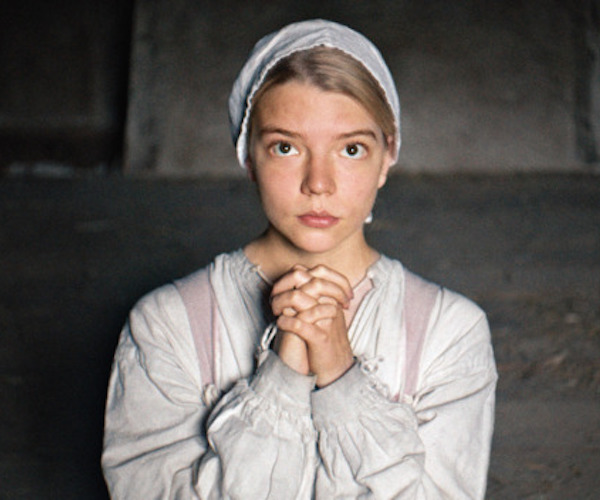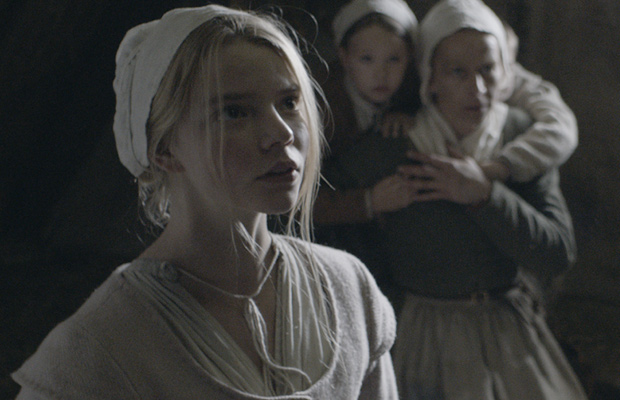Film Review: “The Witch” — Mother Nature’s a Bitch and So am I
The Witch‘s brief jolts of violence seem perfectly calibrated to knock us out of our seats: not by generating horror on the screen, but within our viscera.

Anya Taylor-Joy as Thomasin in “The Witch.”
The Witch, directed by Robert Eggers. At the Kendall Square Cinema, AMC Assembly Row 12, and Somerville Theatre.
By Peg Aloi
It’s a rare film that comes along to shatter our dearest folklores and breathe new life into narrative cliches. Fledgling filmmaker Robert Eggers has crafted an atmospheric, chilling, and sensual depiction of the Colonial witch craze in The Witch. With minimal special effects and a subdued emphasis on the supernatural, the tone throughout is elegantly restrained, with sound and imagery weaving a spell that transports the viewer to a place equal parts idyll and nightmare. The earthy visuals are awash in moody natural light, candle flame, shadows, and mist. The score is minimal yet haunting. Echoing some less-is-more terror narratives of recent years (The Blair Witch Project, Session 9, Martha Marcy May Marlene), Eggers’ brief jolts of violence seem perfectly calibrated to knock us out of our seats not by generating horror on the screen, but within our viscera.
Did you ever wonder why the Salem Witch Trials happened? I mean, crazy, right? Those people accused and executed were all devout Puritans! It was those bitchy, narcissistic servant girls at the heart of it all, bored with drudgery and craving attention. Right? Well, also land grabbing and judicial corruption and moldy grain, I’m told. Thing is, no film I’ve ever seen has drawn so heavily on the era’s cultural imagination to evoke the Salem zeitgeist: what must it have been like to believe that witchcraft could actually cause miscarriages, blight harvests, and prolong impotence (so to speak)? The Witch delves into the dark heart of this distant era, finding both predictable and unexpected motives: childish jealousy, frustration and rage, yes, but also curiosity and yearning. The superstitious awe of nature is laid bare, pointing again and again to the shadowy forest as its crucible.
As the film begins, a man at odds with the leaders of Plimoth Plantation (portrayed with letter-perfect authenticity in its costumes and sets), decides to leave the settlement and set out with his family to establish a homestead. They arrive at the edge of a forest, their meager belongings in a rickety wagon, and smile and praise God for their fortune. Soon enough the household seems to be thriving. William and wife Katherine (Ralph Ineson and Kate Dickie, fine British actors both featured in Game of Thrones) tend their farm and raise their strapping children with frequent doses of thanksgiving and prayer. Their teenage daughter Thomasin (Anya Taylor-Joy, in an incandescent performance) does endless chores and confesses her sins aloud to God. She also teases her pubescent brother Caleb (the very impressive Harvey Scrimshaw), and chases after the mischievous (and, frankly, creepy) young twins Jonas and Mercy (Lucas Dawson and Ellie Grainger).
Thomasin also tends the new baby, and one day at the edge of the forest, while playing peek-a-boo with him, she looks down to find he has vanished. The family suspects a wolf that has been skulking around the homestead. In this moment, fairy tale and folklore converge: the wolf in the woods, the disappeared child, the nubile young woman wandering in the thicket. Katherine is distraught with grief, and Thomasin, left to mind the twins, grows frustrated with their shenanigans, in particular their tendency to make up songs about their golden-eyed long-horned black goat, Black Philip (this damn ram is right out of Central Casting). Mercy prattles on about “the witch in the wood” who signed the devil’s book after making a pact with Black Philip: imagery so richly familiar that, one realizes with a shudder, they must have been exposed to it repeatedly. Thomasin silences her by declaring she is the witch, and Mercy had best behave herself.
The film proffers a none-too-subtle history lesson on the early settlers of New England, who faced dire conditions in the inhospitable climate. We can grudgingly understand these would-be homesteaders would eagerly blame witchcraft for failed crops or sick livestock. Thomasin milks a goat and sees only blood in the bucket; she gathers eggs and finds only a cracked shell holding a dead bloody chick. Things grow tense on the farm. More tragedy ensues after Caleb and Thomasin make a secret trip to the wood to hunt for food, as the meager corn crop promises a slow starving winter ahead. The two are separated, and Caleb has a dreamlike encounter with a red-cloaked witch in the woods. He goes missing for days, and returns home naked in a rainstorm, weak with fever, and has beatific visions of God (Scrimshaw is stunning in this scene).

Anya Taylor-Joy as Thomasin in “The Witch.”
The twins, affected by the brittle mood of the household, eventually accuse Thomasin of cavorting with Satan, and imitate Caleb’s fever-induced fits. Their parents, naturally, believe the devious little imps. Thomasin, aware her father suspects her of witchcraft, angrily confronts William’s failures and hypocrisy. “All you can do is chop wood!” she sneers, a damning metaphor to describe a man who thought to conquer Mother Nature and instead finds himself brought low by the elements. At Katherine’s insistence, William devises a “test” for Thomasin. More blood is shed, animal and human. It seems this family is, indeed, being offered up as a sacrifice.
Even with such an impressive ensemble cast, it is clear this is Thomasin’s story, and it is her world we are asked to imagine. The witch trope has been dramatized onscreen via a myriad of emotional colors: terrifying, benevolent, beautiful, ugly, young, old, seductive, the witch as healer, as magic-worker, as rabble-rouser, a scapegoat, a lover, a killer. Historical portrayals tend to focus on witches as misunderstood outliers, manipulative temptresses, or devout Christians who aren’t witches at all. Without question, the vast majority of these portrayals are female. Kramer and Sprenger, the German misogynists who penned the 16th century witch hunting manual Malleus Maleficarum, wrote “All witchcraft stems from carnal desire, which is in women insatiable.” And this is the moment we must acknowledge the perspective of critics who claim this film is, or is most assuredly not, a feminist story. That Thomasin’s epiphany is either one of empowerment, or of submission. She is broken, dismembered, but her final moments hint at re-membering.
But we must ask: is she evil? Is that what witches are? The most daring and sensible thing would be to embrace the notion that witchcraft, whether ancient or modern, is merely an idiosyncratic expression of the witch herself. Women boiling potions or breaking glass ceilings or smashing the patriarchy are just transforming matter: that’s the nature of magic, after all. Hexing and healing are two sides of a coin (make mine a Susan B. Anthony dollar, please). Thomasin goes to the woods willingly, and what she finds there is not exile, but communion.
If you’re asking me, I find this film to be a passionate paean to the feminine. The forest and the farm at its edge are metaphors we’d all do well to contemplate, but human aggression delivers the most crushing blows here. I’d like to think that, for thoughtful viewers, The Witch may crystallize, then fossilize, and then transcend centuries of abuse, mistrust, and fear. But make no mistake: there is also arrogance here, and cruelty, and selfishness. I am woman, watch me burn. And hang. And drown. And fly through the moonlit night.
Peg Aloi is a former film critic for The Boston Phoenix. She has taught film studies for a number of years at Emerson College and is currently teaching media studies at SUNY New Paltz. Her reviews have appeared in Art New England and Cinefantastique Online, and she writes a media blog for Patheos.com called The Witching Hour.
Tagged: New England, Peg Aloi, Robert Eggers, Salem, The Witch, Witchcraft

Another positive review for a movie that I despise more and more with every positive review I see. The only way I can stand this movie is to see it the way that @Mirasalena01 over at The Wild Hunt sees it — as a pogrom against extremism. Otherwise this is just a depressing fairy tale with the message “If you can’t beat ’em join ’em.” Eggers could’ve saved the energy and money he wasted on period costume and dialogue and filmed this in the modern day as the story of an abused girl giving up and joining a murderous drug gang. But then it wouldn’t have been given rave reviews and been praised as a “passionate paean to the feminine.” Argh!
A murderous drug gang? That’s your modern day parallel? That seems harsh and simplistic. And far wide of the film’s intentions. Did you see it?
[…] without question that Danica has decided to sacrifice her own daughter. I found myself thinking of The Witch and it’s complex mother-daughter struggles, but the implications here are far less thoughtful. […]
Jonas and Mercy were such annoying little brats! I was very happy when the witch took them away, and then Tomasin joined the coven. I assume by that time the coven had run out of Samuel ointment and were using mortar-and-pestled Jonas and Mercy to levitate at the end. Huzzah!